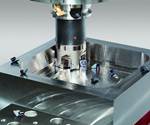
The increased complexity of plastic part geometries requires smaller cutting tools that run at significantly higher speeds, which are only 0.125-inch in diameter, generally. Image courtesy of Precise Tooling Solutions.
To achieve quality, consistent mold machining, the cutting tools used must be selected correctly. This may include keeping up with the latest tool technology and using only high-performance tools with a demonstrated track record. It should also be recognized that today’s complex mold designs require the purchase of different tools with optimal geometry for unique customer applications.
2020 Leadtime Leader Precise Tooling Solutions shares current capabilities and a glimpse of the changes occurring inside its manufacturing operations when it comes to cutting tool technology.
1. Invest in the upgrade of your company’s equipment.
Five-axis technologies such as Roeders and Fermat machines run at significantly higher speeds than previous generation machines. This is in part due to the increased complexity of plastic part geometries, which require smaller cutting tools that run at increased speeds. On average, these newer cutting tools are only 0.125-inch in diameter. Although many smaller tools are shorter, there has been success in using a heat shrink with a longer holder. This approach eliminates vibration and provides a longer reach, enabling users to reach deep into pockets. Updating cutting tools also offers time savings, including less machine downtime and reduced setup times.
2. Improve visibility into one’s machining efficiency via appropriate software installation such as IoT software that provides real-time analytics across the entire manufacturing operation.
This could enable a company to monitor and track production metrics of its machines and provide a more granular understanding of setup times, causes of machine downtime, tool longevity, etc. For example, IoT software that helps to re-engineer an inventory system to offer a cutting tool inventory based on usage rather than intuition.
Also, becoming more involved with vendors ensures a company is able to educate itself on new products and best practices that could potentially improve capabilities and deliver world-class products to customers.
3. Stay on top of continued advances in technology that drive improvements in cutting tool accuracy and increase tool longevity.
These advancements can be found with new coatings for heat reduction and indexable cutting tools that offer increased efficiency via the ability to get four uses out of each insert.
More broadly, mold designers will stretch the limits of new software to design even more complex molds for evolving customer (consumer) needs. We also expect molders will be using new compounds. In turn, these developments will require moldmakers to remain agile with their approach to cutting tools, machining hardware and CAM software.
Related Content
-
Treatment and Disposal of Used Metalworking Fluids
With greater emphasis on fluid longevity and fluid recycling, it is important to remember that water-based metalworking fluids are “consumable” and have a finite life.
-
How to Use Continuing Education to Remain Competitive in Moldmaking
Continued training helps moldmakers make tooling decisions and properly use the latest cutting tool to efficiently machine high-quality molds.
-
Products and Services for Multiple Moldmaking Needs
New year, new technology roundup! Featured here is a collection of product offerings, from profile milling cutters to industry-specific CAD/CAM software to innovative hot work tool steels.

















